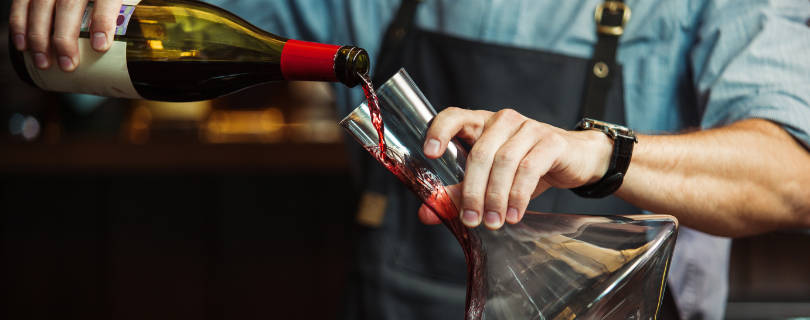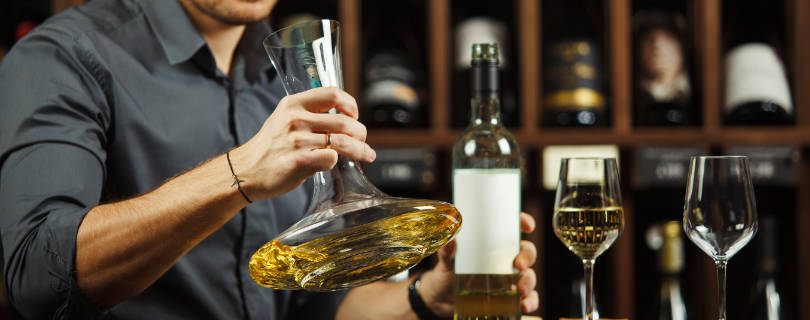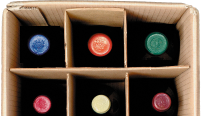So, what exactly does it mean to decant wine, and how do you go about it? And is it necessary for both red and white wines? Read on for the answers to these questions and more!
What does decanting wine mean?
Decanting involves slowly pouring the wine from its original bottle into a different container without disturbing the sediment at the bottom. Any type of container can work, but most people choose a glass or crystal decanter with a broad base, narrow neck and sloped sides. The wine is then left to ‘open up’ before it’s ready to drink.
There are two main reasons for decanting wine:
Aeration – Decanting is a way of introducing some oxygen to your wine. When wine interacts with the oxygen in the air, the flavours open up, and the bouquet develops, enhancing the overall taste. This process is particularly good for younger, more tannic red wines, which can be softened through aeration.
Sediment separation – Over time, some wines, particularly older red wines, can develop sediment in the bottle. Decanting allows you to separate this sediment from the wine, ensuring a smoother, more pleasant drinking experience.

Is it worth decanting wine?
In short, the answer is yes! Decanting appropriate wines can greatly enhance your enjoyment, particularly in the case of young, tannic red wines or older red wines with sediment.
By letting these wines take in oxygen, their aromas, flavours and texture can soften and become more expressive, providing a more satisfying taste.
In situations where the cork has broken, decanting can rescue the wine by separating the bits of cork from the liquid.
What wines should you decant?
Decanting is beneficial for a wide variety of wines - but not all!
Some red wines – Full-bodied red wines with firm tannins can benefit from decanting. Examples include Bordeaux, Burgundy, Cabernet Sauvignon, Malbec and Shiraz (Syrah). Older reds can form sediment in the bottle, so decanting can separate it from the wine to be enjoyed (look for game and leather notes, which can develop as tertiary characteristics in cellared red wines).
Vintage port – To fully appreciate a vintage port, decanting is crucial. Bottle-aged ports have a higher sediment accumulation compared to cask-aged ones. Beyond sediment separation, decanting enriches the port’s dried fruit, caramel, nuts and other complex aromas, intensifying the tasting experience.
Certain aged white wines – It’s uncommon to decant white wine, but certain fuller-bodied, aged white wines can also benefit from decanting, as the process helps these wines reveal their complex aromas and flavours. For example, the process can highlight secondary characters from oak-aged white wines such as Chardonnay. These can include buttery qualities from malolactic fermentation and creaminess from lees stirring.

It’s worth noting that light, fresh white wines, rosés and sparkling wines are generally best served straight from the bottle to preserve their crisp, fresh characteristics and effervescence.
Rosé wines have a delicate structure that can be disrupted by aeration. If you wish to serve your rosé from a carafe or decanter for presentation purposes, consider transferring the chilled wine right before serving.
How to decant wine
While it’s a relatively simple process, decanting wine requires some care. Despite the simplicity of the action, each step – from deciding when to decant to pouring carefully and then waiting for the wine to breathe – requires some consideration. This is important if you want to enjoy the wine’s full range of flavours.
Follow these steps for successful decanting:
Choose the right decanter – Your glass or crystal decanter should be clean and dry, with a wide bottom to let more of the wine’s surface have contact with air.
Prepare the wine – If you’re decanting an older wine with sediment, let the bottle stand upright for about 24 hours before decanting to allow the sediment to settle.
Remove the Stelvin (a type of screwtop) or cork – Carefully uncork the bottle of wine. If decanting an older wine, consider using a two-prong cork puller to avoid breaking a fragile cork.
Pour the wine – Slowly start pouring the wine into the decanter. To minimise spillage, hold the decanter at an angle and let the wine glide down the side of the decanter.
Watch the sediment – With older wines, watch the neck of the bottle as you pour carefully. Try using a strong light under the bottle (with a torch, for example) too see where the sediment is. Once you begin to see sediment reach the neck, stop pouring. The goal is to leave most of the sediment in the bottle.
Let the wine breathe – Once decanted, let the wine breathe. This period of aeration can range from 15 minutes for a light wine to several hours for a heavier wine. During this time, the wine will interact with the oxygen, causing it to open up and reveal its full range of flavours and aromas.
Serve the wine – After it has had time to breathe, pour your wine into a glass and enjoy!
Got a magnum to decant? Depending on the size of the bottle and the decanters, you may need to have multiple decanters ready. Decant the wine continuously to avoid disturbing the sediment, and have an extra pair of hands to help in case you need to switch decanters or keep the bottle steady while decanting.

How to decant a vintage port
Here are three easy steps to decanting a vintage port:
Start by positioning the bottle upright. If the port is less than 40 years old, leave it to stand upright for 10-15 minutes, and up to 30 minutes for older ports.
Pour the port slowly and consistently into your decanter, being careful to stop pouring once you notice sediment appearing in the neck of the bottle.
Leave it to rest in the decanter before serving. For vintages up to 40 years old, decant two to three hours before serving. For older vintages, 30 minutes to an hour should suffice.
How long should you decant wine for?
How long you should leave your decanted wine to ‘breathe’ depends on the type and age of the wine. Here are some general guidelines:
Light-bodied red wines such as Pinot Noir, Gamay (Beaujolais), Valpolicella, Zweigelt and Schiava generally require 20–30 minutes.
Medium-bodied red wines, including Cabernet Franc, Grenache, Merlot, Malbec and Tempranillo, typically benefit from 30-60 minutes.
Full-bodied red wines, such as Shiraz, Cabernet Sauvignon, Bordeaux, Rioja and Durif often need 60 minutes or more.
Older red wines may see their flavours and aromas fade if exposed to oxygen for too long. Decant them for 30 minutes to an hour.
White wines - Although not common, some fuller-bodied or aged white wines can benefit from a short decant for 30 minutes to an hour.
How do you know if the wine is ready to drink?
Generally, if the wine tastes good, it’s ready to be enjoyed! If you’re finding it difficult to detect those fruity notes and aromas, or if the wine tastes excessively tannic, the wine may still be ‘closed’ and could benefit from further decanting. A wine sipped straight out of the bottle can be quite different when allowed to open up and ‘breathe’.
Discover our collection of wines, from red, white and rosé to sparkling wine.

















